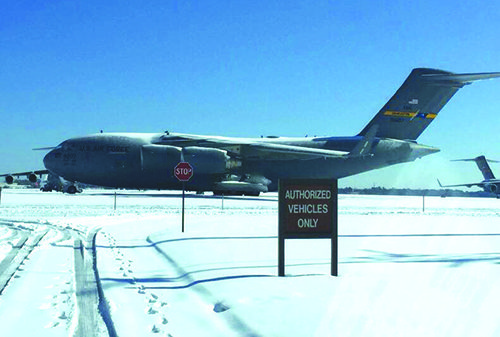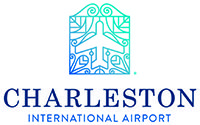Even during the most bitter winters, the Southern port city of Charleston, SC, seldom experiences a deep freeze. But last winter proved to be a major exception. Winter Storm Grayson shocked residents and effectively closed the airfield shared by Charleston International Airport (CHS) and Boeing SC at U.S. Air Force Joint Base Charleston from Jan. 3 to 7.
“It has probably been over one hundred years since we had that kind of ice and snow,” says Paul G. Campbell Jr., executive director and chief executive officer of CHS. “We had four days in a row that it never got above freezing. It would just get warm enough at the end of the afternoon to get a little bit of a melt, and then it would refreeze again overnight.”
With temperatures hovering in the teens and up to 3 inches of ice accumulated on the runways, the Charleston County Aviation Authority and U.S. Air Force—which owns the shared runways—were simply not equipped to handle the highly unusual winter storm.
|
Project: Winter Storm Readiness Location: Charleston (SC) Int’l Airport Stakeholders: Charleston County Aviation Authority; Joint Base Charleston; Boeing SC Catalyst: Winter Storm Grayson, Jan. 3-7, 2018 Facility Damage: Nominal Associated Lost Revenue: About $700,000 Inaugural Task Force Meeting: Jan. 30, 2018 Memorandum of Agreement: June 14, 2018 Strategy: Put contractors on retainer to assist with snow/ice removal & facility repairs |
Weathering the Anomaly
Based on the airfield’s geographic location and the historical infrequency of snow events, the Air Force does not own or maintain any airfield equipment specifically designed for snow and ice removal at Joint Base Charleston and CHS. Furthermore, there was not an effective plan in place for clearing the unexpected ice and snow.
However, a coordinated effort between Charleston County Aviation Authority, Joint Base Charleston and Boeing SC safely cleared enough snow and ice to reopen Runway 03-21 by noon on Jan. 6. Flight operations and the entire airfield reopened the following day at 2 p.m.
In order for the entire base installation to resume normal operations, crews had to recover the airfield, remove snow on the roads and address facility issues such as broken water lines and damage to the heating, ventilation and air conditioning system. “These services are taken for granted until they’re no longer there,” says Col. Rockie Wilson, 628th Mission Support Group Commander. “When the power or water goes out, or people are unable to pass through roads, response teams kick in and save the day.”
Col. Jeff Nelson, 628th Air Base Wing Commander, commends the dedication of personnel throughout the base installation to bring the airfield and base back up to full operations—everything from security forces patrolling roadways for travelers to weather specialists monitoring conditions and providing vital storm updates.
“From the beginning, our priority was safety,” notes Nelson. “A great deal of caution and consideration had to be taken into account as we worked through our response to this historic snow storm and multiple days of temperatures below 40 degrees. Many of our teammates worked long hours to ensure the safety of both our personnel and resources.”
Local municipalities and the South Carolina Department of Transportation worked hard to clear main roads in the surrounding area, he adds. Subsequent crews that cleared surrounding roads enabled people to travel to and from the airport once the runways were cleared.
“It took a great deal of teamwork and resourcefulness throughout the storm, and I’m thankful for the men and women who worked around-the-clock to restore operational capability at the airfield,” says Nelson.
Campbell was similarly impressed by and grateful for the widespread responsiveness.
“It was an unusual set of circumstances that caused us to go through a learning curve, but we had a really great team,” he reflects. “I can’t say enough good things about the United States Air Force at Joint Base Charleston and Boeing. We work very well together.”
Call to Action
After airfield operations returned to normal, CHS and Joint Base officials initiated a comprehensive strategic review. While property damage was nominal, Winter Storm Grayson caused both organizations to incur other costs. Doug Boston, chief financial officer for the aviation authority, estimates that CHS suffered revenue losses from flights, concessions and associated businesses of approximately $700,000.
“We realized the need to identify and review the lessons learned from this historic storm to build a better plan to improve our relationships, readiness and response to assist us in clearing ice and snow from the taxiways and runways for future, albeit 20-year, events,” explains Nelson.
A taskforce of subject-matter experts was created on Jan. 30 to review lessons learned and study the weather-related emergency response plan for the shared airfield. After five months of discussions, the Joint Base and Charleston County Aviation Authority signed a formal memorandum of understanding to address the cooperation and coordination of snow removal operations at the jointly-used facilities.
 “We will meet annually in the fall to conduct pre-season winter weather management coordination and issue a plan to each of our organizations to improve our readiness and coordination required for snow and ice removal from the airfield during significant winter weather related events,” says Nelson. The new memorandum does not supersede nor void the more comprehensive existing joint-use agreement between the U.S. Air Force and Charleston County Aviation Authority.
“We will meet annually in the fall to conduct pre-season winter weather management coordination and issue a plan to each of our organizations to improve our readiness and coordination required for snow and ice removal from the airfield during significant winter weather related events,” says Nelson. The new memorandum does not supersede nor void the more comprehensive existing joint-use agreement between the U.S. Air Force and Charleston County Aviation Authority.
New Response Plan
To supplement the pre-season coordination meetings, a snow control command structure is ready for activation when inclement winter weather has the potential to affect airfield operations. The command center will coordinate activities related to winter weather response such as pavement clearing operations and airfield assessments. It will help ensure that runways, taxiways and ramps remain operational before, during and after inclement winter weather by providing updates related to current runway surface conditions. Other responsibilities include drafting Notice to Airmen (NOTAM) updates for dissemination; managing inventory, location, storage and staging of equipment and deicing chemicals and applications; and discussing procurement actions and disposal of snow and ice in compliance with the Clean Water Act and applicable state regulations related to stormwater management, snow and ice containment and collection and snow removal.
 Retainers vs. Purchases
Retainers vs. Purchases
While the new memorandum of understanding dictates increased communications and command, it does not call for the purchase of dedicated equipment to clear snow and ice. Instead, contractors will be put on retainer to bring plows and other equipment to the airfield in the case of another weather anomaly. This approach is more cost-effective given the rare occurrence of snow and ice storms in Charleston, explains Campbell.
The recent experience with Boeing SC serves as an effective blueprint. The aerospace company, which is located adjacent to CHS and shares the runways and taxiways with the Air Force Base and airport, used its own equipment to assist Aviation Authority and Joint Base personnel in clearing the snow and ice, returning runways to operational status and fixing damage caused by Winter Storm Grayson.
Boeing SC will participate in the planning/response meetings and work with the Air Force Base and Aviation Authority to tackle any future storm issues, although specific duties have yet to be assigned.
 “We are going to have a standing agreement with contractors, so they can come in quickly,” Campbell says, noting that they are still identifying and securing companies to be on standby for clearing operations. “We may even, in the meantime, stock a few of the chemicals to put down if we see a storm coming.”
“We are going to have a standing agreement with contractors, so they can come in quickly,” Campbell says, noting that they are still identifying and securing companies to be on standby for clearing operations. “We may even, in the meantime, stock a few of the chemicals to put down if we see a storm coming.”
Nelson is similarly optimistic about contingency plans put in place after last winter’s unusually harsh weather. “In partnership with the Charleston Aviation Authority, we are better prepared to jointly plan and respond to any similar severe winter weather related storms affecting our airfield operations and ensure our military readiness to support our rapid global mobility mission,” he remarks. “Our goals for future similar weather-related events include providing coordinated responses, relying on our strong partnerships and ensuring Joint Base Charleston remains postured to respond to potential inclement winter weather.”


 facts&figures
facts&figures

